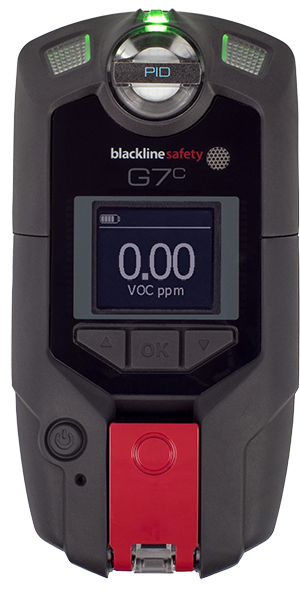G7 wearables and G7 EXO area monitors constantly detect both VOC ambient gas levels and the employee's location, reporting this data back to the cloud wirelessly via cellular or satellite connectivity. These devices utilize advanced sensors for VOC detection, capable of measuring very low concentrations of organic chemicals and other air pollutants that can affect indoor air quality.
Every reading streamed to the cloud ensures that all data is immediately available for visualization of PID readings on a map overlay, giving Industrial Hygienists and HSE Managers the ability to identify hotspots and problem areas and take proactive action to address an issue before it becomes an incident. This real-time monitoring is crucial for detecting VOC emissions from various sources such as building materials, office equipment, cleaning supplies, and industrial emissions.
PID VOC
The devices utilize photoionization detection (PID) technology, commonly referred to as a PID detector or photoionization detector, which harnesses UV light to ionize VOC gases—volatile organic compounds—with ionization thresholds below the photon energies emitted by the lamp. This advanced method, often integrated into PID multi-gas monitors, enables the detection of a wide range of organic solvents, including benzene, and other gases at remarkably low concentrations, down to the ppb range (parts per billion), far beyond what’s visible to the naked eye.
With high sensitivity, these calibrated tools measure VOC monitoring needs effectively, identifying compounds with high vapor pressure at room temperature, such as those emitted from paint strippers, permanent markers, photographic solutions, and craft materials. Many VOCs are notorious for their adverse health effects, potentially affecting the central nervous system, causing throat irritation, and necessitating robust personal protection strategies.
Though many VOC gases remain invisible, their emissions significantly degrade both indoor and outdoor air quality, posing environmental challenges. Characterized by their high vapor pressure, these compounds evaporate readily, mingling with other air pollutants—like oxygen-depleting substances—to form complex mixtures. Unlike visible light, which we can perceive, VOC emissions often go undetected until they reach hazardous levels, making multi-gas monitors essential for detecting leaks and ensuring safety during confined space entry. Alongside other pollutants, VOCs can have serious health implications, emphasizing the need for precise measurement in ppm (parts per million) and comprehensive air quality management. From industrial processes to everyday household products, the diverse sources of these volatile organic compounds highlight the critical role of advanced monitoring and control measures.
The G7 ecosystem, featuring PID multi-gas monitors, excels at detecting and monitoring VOCs, offering invaluable support in preventing and responding to chemical spills, detecting leaks, and maintaining air quality across various settings. By delivering real-time data on VOC levels with pinpoint accuracy, these devices empower proactive steps to safeguard human health, enhance personal protection, and ensure safer working environments—whether in industrial facilities or confined spaces requiring meticulous environmental oversight.
Typical Applications
- Personnel safety
- Industrial hygiene
- Soil contamination and remediation
- Unintended emissions
- Law enforcement
- Emergency response
- Leak detection
- Perimeter monitoring
- Refineries and petrochemical
- Air quality monitoring
Historical alert reporting
Gas logs streamed from each G7 device generate a large volume of data that is processed by the Blackline Live compliance dashboard. Blackline Analytics enables users to gain insights into how and where equipment is being used, where hazards are being encountered and every bump test, calibration and gas exposure is automatically recorded.

Innovative gas sensor technology
The ION Science MiniPID 2 delivers dynamic and dependable response to a wide range of volatile organic compounds (VOCs) in a broad range of applications.
- • Humidity-resistant
- • Anti-contamination design
- • 10,000 hours lamp life
- • World leading temperature stability
- • 10.6 eV lamp
- • Internal gas table with over 700 VOCs & toxic compounds
- • Expected life > 5 years
The MiniPID 2 sensor includes patented Fence Electrode Technology to give results you can trust in the most challenging environments by providing industry-leading humidity resistant performance and anti-contamination design, protecting the sensor from moisture, dust and aerosols. Designed for both diffusion and pumped sampling, MiniPID 2 delivers an exceptional response time.
Incorporating a next- generation long-life lamp, the MiniPID 2 provides exceptional stability and long-term performance, enabling reliable detection for 10,000 hours of use. As a result, the MiniPID 2 requires significantly less maintenance, than previous-generation PID sensors.




